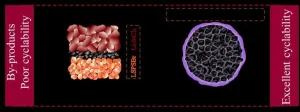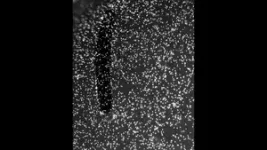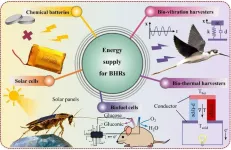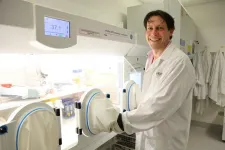(Press-News.org)
They published their work on Oct. 18 in Energy Material Advances.
"Constructing a good interface between cathode and electrolyte is crucial for the development of all-solid-state battery," said Chuang Yu, a professor at the State Key Laboratory of Advanced Electromagnetic Technology at Huazhong University of Science and Technology. "Currently, strategies such as coating protect layer on cathode surface and isolating cathode/sulfide electrolyte by halide electrolyte layer are typical solutions to solve the problems at the interface between the cathode and the sulfide electrolytes, but it is not yet clear who is more suitable for sulfide-based all-solid-state batteries."
Yu explained that sulfide electrolytes currently used will undergo oxidative decomposition during the operation, which deteriorates to cyclability, and strategies should be employed to suppress such decomposition.
"Halide electrolytes have wide electrochemical windows which can compensate for the shortage of sulfide electrolytes," Yu said. "The coating layer of the cathode surface can relieve the decomposition of sulfide electrolytes. Both strategies are favored to cycle performance."
But it's too simplistic to think that introducing halide electrolytes can significantly improve the cycling performance of batteries. According to Yu, the use of halides introduces a new interface that is the halide/sulfide interface. The compatibility is not fully understood yet between two electrolytes and efforts should be made to explore the answer.
"We take Li9.9SnP2S11.9Br0.1 sulfide electrolyte as an example, employing cathode surface coating and halide/sulfide bilayer electrolyte strategies to improve the electrochemical performance of batteries," Yu said. "The cycle performance of batteries with a coating layer is excellent. The initial discharge capacity of halide/sulfide bilayer electrolyte batteries is very high but the cyclability is undesirable."
"This provides us with an opportunity to explore the stability of halide/sulfide interface, as batteries with bilayer electrolyte have poor cycle performance. In fact, they are indeed unstable, and after a period of contact, the impedance of the two is significantly lower than when they contact at the beginning," Yu said.
"The products between halide and sulfide, such as In2S3, are the main culprit causing poor cycling performance," Yu added. "Strategies should be explored to enhance the interface stability between halide and sulfide. Otherwise, the only way to significantly enhance the cycling performance of batteries is to use the coating method on the cathode surface."
Other contributions include Qiyue Luo, Liang Ming, Chaochao Wei, Zhongkai Wu, Ziling Jiang, Chen Liu and Shijie Cheng, State Key Laboratory of Advanced Electromagnetic Technology, School of Electrical and Electronic Engineering, Huazhong University of Science and Technology; Shiyu Liu, Wuhan National High Magnetic Field Center, Huazhong University of Science and Technology; Dong Zhang and Kecheng Cao, School of Physical Science and Technology & Shanghai Key Laboratory of High-resolution Electron Microscopy, Shanghai Tech University; Long Zhang, College of Physics and Energy, Fujian Normal University.
The National Key Research and Development Program (2021YFB2500200). This work is also supported by the National Natural Science Foundation of China (Nos. 52177214) and the National Key Research and Development Program (2021YFB2400300). This work uses resources of Analytical and Testing Center of Huazhong University of Science and Technology.
###
Reference
Authors: QIYUE LUO, LIANG MING, DONG ZHANG, CHAOCHAO WEI, ZHONGKAI WU, ZILING JIANG, CHEN LIU , SHIYU LIU, KECHENG CAO , LONG ZHANG, CHUANG YU , AND SHIJIE CHENG
Title of original paper: Constructing Br-Doped Li10SnP2S12-Based All-Solid-State Batteries with Superior Performances
Journal: Energy Material Advances
DOI: 10.34133/energymatadv.0065
Affiliations: 1State Key Laboratory of Advanced Electromagnetic Technology, School of Electrical and Electronic Engineering, Huazhong University of Science and Technology, Wuhan 430074, P. R. China. 2School of Chemistry and Chemical Engineering, Huazhong University of Science and Technology, Wuhan 430074, P. R. China. 3School of Physical Science and Technology & Shanghai Key Laboratory of High-resolution Electron Microscopy, Shanghai Tech University, Shanghai 201210, P. R. China. 4Wuhan National High Magnetic Field Center, Huazhong University of Science and Technology, Wuhan 430074, P. R. China. 5College of Physics and Energy, Fujian Normal University, Fuzhou 350117, P. R. China
About the Author: Chuang Yu is currently a professor at Huazhong University of Science and Technology | Hust School of Electrical and Electronic Engineering. His research interest focuses on all-solid-state lithium and sodium ion electrolytes and their applications in solid-state Li and Na cells.
END
Bio-machine hybrid robots (BHRs) represent a new generation of micro-aerial vehicles that be controlled by building an interface between biological and artificial systems. In contrast to conventional bionic robots, they are free of complex mechanical structures, and due to the direct adoption of the animal body, they have superior moving characteristics and lower energy demand. Thus, the BHRs can be applied in many important scenarios, such as urban and wilderness rescue operations, environmental monitoring and hazardous area surveys.
To accomplish long mission endurance, the energy supply ...
Johns Hopkins researchers looking to develop a long-acting, injectable malaria preventive using atovaquone have shown in a new study that resistance may not be the challenge scientists thought it was, particularly when using atovaquone as a malaria preventive. Malaria parasites in infected patients being treated with atovaquone tend to develop a resistance to the drug. Because of this, atovaquone by itself is not used as a malaria treatment nor has not been seen as a strong candidate for use as a preventive.
The study, led by a team of researchers at the Johns Hopkins Malaria Research Institute and the Johns ...
New findings from researchers at UCLA Health suggest that measuring changes in how pupils react to light could help predict recovery from depression and personalize transcranial magnetic stimulation (TMS) treatment of major depressive disorder.
TMS is a safe, non-invasive therapy that uses magnetic fields to stimulate parts of the brain involved in mood regulation. While TMS is proven effective, not all patients respond equally well to the therapy. The ability to predict who will benefit most could allow doctors to better customize ...
Women with diets during middle age designed to lower blood pressure were about 17 percent less likely to report memory loss and other signs of cognitive decline decades later, a new study finds.
Led by researchers from NYU Grossman School of Medicine, the new findings suggest that a mid-life lifestyle modification – adoption of the Dietary Approaches to Stop Hypertension, or DASH diet – may improve cognitive function later in life for women, who make up more than two-thirds of those diagnosed with Alzheimer’s disease, the most prevalent form of dementia.
The findings, published online today in ...
The winners of the Society’s prestigious annual Awards for 2024 have all contributed to improving knowledge and expertise in endocrinology and have helped drive innovation and progression across the field.
Each of these deserving winners will be presenting a plenary lecture at ESE’s annual Congress, the European Congress of Endocrinology (ECE) 2024, which will be held in Stockholm, Sweden from 11-14 May 2024.
The 2024 Geoffrey Harris Award is being presented to Jens C. Brüning (Germany). This Award recognises outstanding researchers in the field of neuroendocrinology. Jens Brüning is the Director of the Max Planck Institute for Metabolism Research ...
The more diverse species in your gut, the better it is for your health. Now an international team led by the Hudson Institute of Medical Research has found a way to determine which species are important and how they interact to create a healthy microbiome.
Understanding these relationships opens the door to a new world of medical opportunities for conditions from Inflammatory Bowel Disease to infections, autoimmune diseases and cancers.
Associate Professor Samuel Forster and his team at Hudson Institute of Medical Research, working with collaborators from the Institute for Systems Biology in ...
Felix Beuschlein is Professor of Internal Medicine/Endocrinology and Director of the Clinic for Endocrinology, Diabetology and Clinical Nutrition at the University Clinic Zurich in Switzerland. He received his medical degree from School of Medicine at the University of Würzburg and completed his medical training in Freiburg, both in Germany. For postdoctoral studies he joined the University of Michigan in Ann Arbor. Following a professorship for Endocrine Research at the University of Munich, he was elected for a chair position at the University of Zurich in 2017.
The Transatlantic ...
A new partnership between Edith Cowan University (ECU), observation data company QL Space, and University of South Wales (UK) is looking to the stars, literally, to create more secure and efficient communication.
The collaboration will focus on ‘free space optics’, which uses light all around we can’t see to communicate, by sending data via light particles, or photons.
ECU School of Science Senior Lecturer Dr Shihao Yan said this brought with it many benefits compared to using radio frequencies to send information.
“When ...
AAP media contacts: Lisa Black, 630-626-6084, lblack@aap.org
Tom McPheron, 630-626-6315, tmcpheron@aap.org
...
AAP media contacts:
Lisa Black, 630-626-6084, lblack@aap.org
Tom McPheron, 630-626-6315, tmcpheron@aap.org
Adam Alexander, 630-626-6765, aalexander@aap.org
Washington, D.C.— Teenagers and young adults are fairly open to the idea of talking with their doctors and nurses about their sexual orientation and gender identity and are okay being asked through various methods, whether on paper, electronically, or in person, according to research presented during the 2023 AAP National Conference ...




